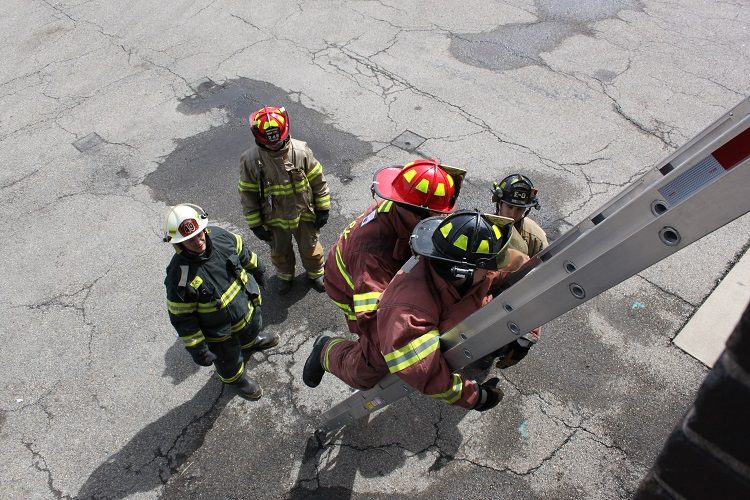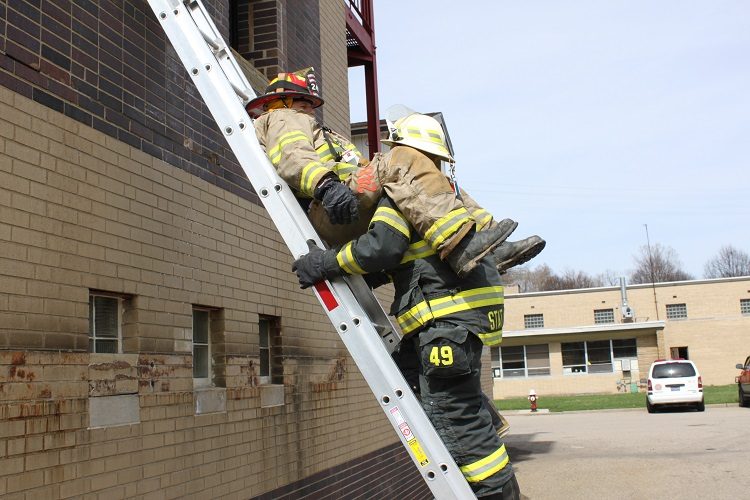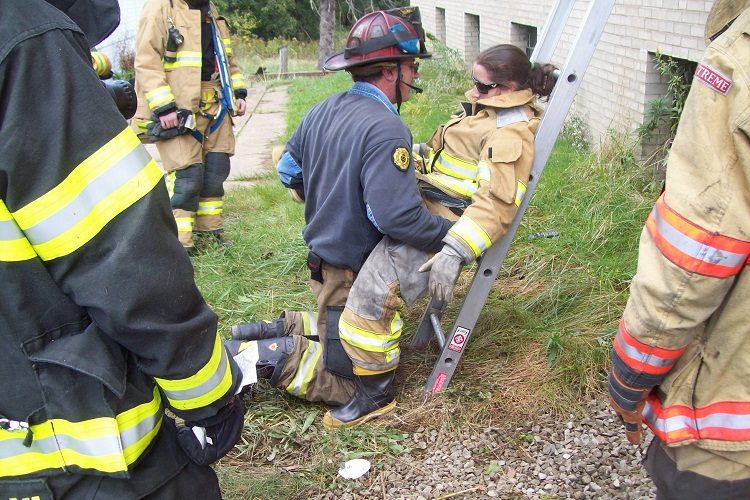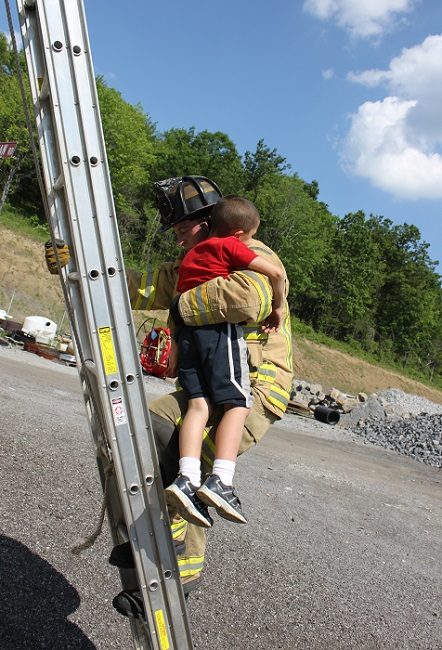By Mark van der Feyst
Last month, I looked at how to bring a victim down a ground ladder horizontally with the victim facing the ladder. The firefighter will have his arms through the victim’s legs and underarm area to secure him to the ground ladder and maintain control while descending. As mentioned previously, there are other methods to remove a victim down a ground ladder such as the “vertical victim” technique. With this option, there are two variations—with the victim facing away from the firefighter and the victim facing the firefighter.
You can accomplish both removal techniques with just one firefighter. If the firefighter can maintain control, he will be able to bring the victim down the ground ladder and then get help at the bottom for removal to awaiting emergency medical services (EMS) crews. It will take much exertion to descend the ground ladder with a live person; you will need help to drag or carry him away to wherever EMS is set up.
You must pass the victim’s feet out of the window first, with the victim being either face up or face down. The victim can be either conscious or unconscious, with him facing away from the firefighter. If he is facing the firefighter, he will most likely be conscious. Having an unconscious person facing the firefighter vertically will make the removal very difficult and unstable.
Using the technique where the victim is facing away from the firefighter, the firefighter will be positioned behind the victim using his arms and one leg to support the victim’s weight. In photo 1, the angle of the ground ladder is important with this technique.

With the ladder positioned at approximately 75°, the weight of the firefighter and the victim will be supported and transferred to the beams and then directly to the ground. It is especially important to have the ground ladder on a hard surface to prevent it from “kicking out.” Having another firefighter heeling the ladder will prevent this from happening.
The firefighter’s arms are under the armpits of the victim and one of his legs is between victim’s legs. In photo 2, the victim’s legs should be on the outside of the ladder beams to keep his legs clear from the firefighter’s climbing path and prevent any tripping or leg entanglements.

The difficult part in this technique is removing your leg from between the victim to step down to the next rung. To make this a little bit easier, the firefighter should roll his wrists upward toward the ladder before removing the victim’s leg. Doing this relieves some of the victim’s weight off the firefighter’s knee, allowing the leg to be removed. Do this all the way down the ladder and to the ground.
If the victim regains consciousness or starts to lose control, the firefighter can pull himself to the ladder, pinning the victim to regain control. This is a very effective way to control the victim. Once at the bottom of the ladder, the firefighter can drag the victim away from the it to awaiting EMS crews.
With the victim facing the firefighter, the victim’s weight will be resting on the firefighter’s shoulders as well as the ladder. In photo 3, the victim sits on the ladder with his legs resting on top of the firefighter’s shoulders. The victim must be conscious in this position to be removed.

The victim’s buttocks area should be around the firefighter’s chest area, which will help with weight distribution and reduce fatigue on the firefighter’s arms. The firefighter will have his hands on the beam of the ladder, allowing him to slide down smoothly during the descent. The victim’s back will slide down the ladder’s rungs. Depending on the victim’s size, part of his back will also slide down the ladder’s beams. The rungs may create a rash on the victim’s back, but it is a small price to pay to get him out of the building alive.
Once at the bottom of the descent, the firefighter can let the victim rest on his one knee. Photo 4 shows how this is set up. The victim resting on the firefighter’s knee allows the victim to disembark from the ladder on his own or give time for assistance to come and help in his removal.

When dealing with small children (depending on their size), the removal technique will vary. They can lie across the firefighter’s arms horizontally, as in photo 5, or they can be carried in one arm, as in photo 6. They can also be passed off to another firefighter below if there is more than one child needing removal.


Practicing these various removal techniques on an individual of any size or age will help you in perfecting and gaining confidence in employing them.
Mark van der Feyst has been in the fire service since 1999 and is a full-time firefighter in Ontario, Canada. He is an international instructor teaching in Canada, the United States, and India, and at FDIC. Van der Feyst is a local level suppression instructor for the Pennsylvania State Fire Academy. He is also the lead author of Residential Fire Rescue (Fire Engineering Books & Video).
MORE MARK VAN DER FEYST
- Back to Basics: Pulling the Flat Load Off the Rig
- Back to Basics: Helicopter Safety
- Truck Company Operations: Using the Rotary Saw, Part 2
- Truck Company Operations: Using the Rotary Saw, Part 1
- Mark Van Der Feyst: Using the Ongoing Size-Up to Build a Profile for Rescue
- Truck Company Basics: Ground Ladders
- Truck Company Ops: Ladder Angles

